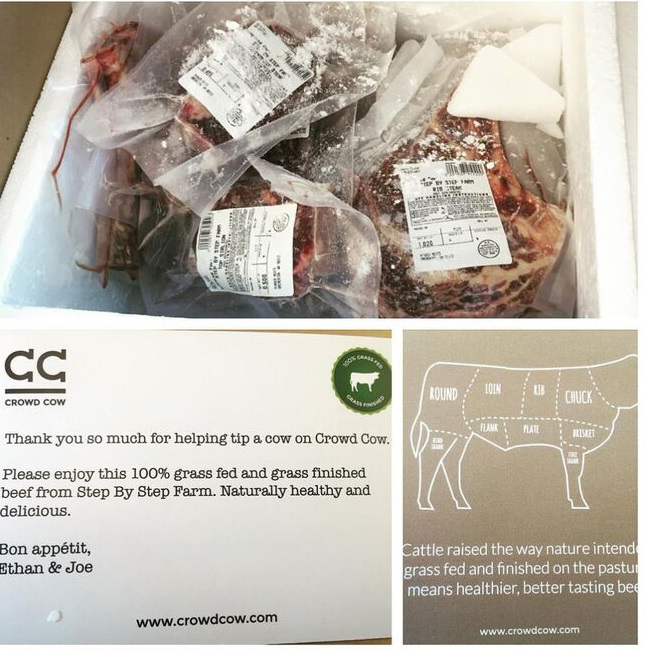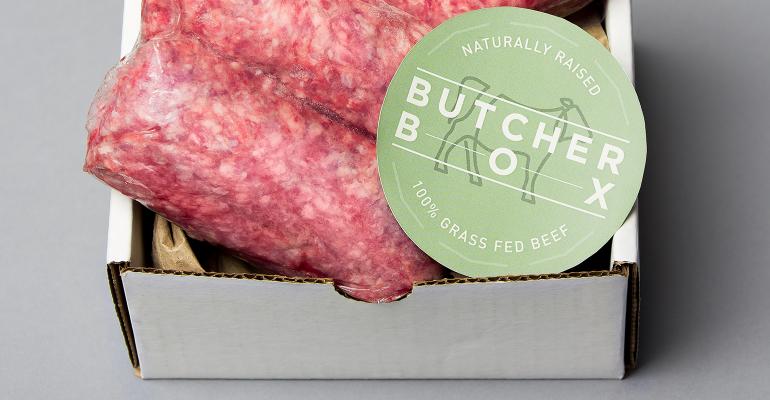Internet-based meat purveyors, including ButcherBox and Crowd Cow, have been growing quickly by offering product that may be difficult for consumers to find in their local supermarkets.
Using sales models that have proven popular in other applications, ButcherBox and Crowd Cow also each add unique twists to the business of offering direct-to-consumer meat delivery.
ButcherBox follows the model of other “subscription box” concepts that allow consumers to have a curated selection of product delivered each month. From its shipping facility in Wisconsin, ButcherBox mails out a package that includes about 20 meals’ worth of preportioned, frozen beef, pork and chicken to its 20,000 customers.
 Founder and CEO Mike Salguero launched ButcherBox in 2015 when he said he and his wife were having trouble finding the variety of “clean” beef cuts they were looking for in their local supermarkets.
Founder and CEO Mike Salguero launched ButcherBox in 2015 when he said he and his wife were having trouble finding the variety of “clean” beef cuts they were looking for in their local supermarkets.
“The big difference between us and a grocery store is … we are able to do cuts that customers have never had before or the grocery store would never carry just because the market size is just too small,” Salguero said.
He said even his local Whole Foods Market near where he lives in Cambridge, Mass., carries only a limited selection of grass-fed beef cuts.
ButcherBox sources only grass-fed beef, pasture-raised pork and organic, free-range chicken. It bundles a combination of products, which it selects itself from ranchers across the U.S. and overseas for a monthly fee of $129. It also offers a double-size box for $238, and allows customers to add items to the boxes as well.
Currently, customers can only select from a limited menu of boxes, including all-beef or beef-and-chicken only, for example. The company is testing a model in which consumers can have more control over what goes into each box.
“We do well as a ‘meat discovery’ platform, because we give them cuts they’ve never had before,” said Salguero. “But a lot of people just want their three pounds of chicken breast, some steaks and ground beef.”
He said the company has two broad groups of customers: urban professionals who don’t have time to source out premium meats themselves, and consumers in more rural communities who might not have premium meats available in their areas.
Pooling resources
Meanwhile at Crowd Cow, as the name implies, the company employs a model similar to crowd sourcing, in which groups of buyers pool their resources to buy large quantities collectively. The Seattle-based company purchases premium cattle from small ranchers that meet strict criteria, has the cattle butchered and then sells them in “shares” online to buyers. The products are flash-frozen and packed with dry ice for shipping, using a variety of carriers.
 A key advantage for customers is that they gain access to premium, humanely raised beef without having to buy whole cattle, or hundreds of pounds of beef, directly from ranchers, said Laura Troyani, head of marketing at Crowd Cow.
A key advantage for customers is that they gain access to premium, humanely raised beef without having to buy whole cattle, or hundreds of pounds of beef, directly from ranchers, said Laura Troyani, head of marketing at Crowd Cow.
“You can buy an entire steer from a rancher, but it is hard to buy smaller pieces,” she said, noting that these smaller ranchers generally sell large orders to high-end restaurants and specialty butchers.
“We offer the same quality of buying directly from the rancher, but the convenience of just getting what you want and having it delivered to you,” said Troyani.
Each “share” — a group of cuts from a single animal — is sold by the pound at prices that are comparable to those at premium butchers, Troyani said. Crowd Cow offers shares as low as $99, but average tickets are in “triple digits,” she said.
Once an entire steer has been sold, the products are shipped.
The company was founded by Joe Heitzeberg and Ethan Lowry, veteran technology entrepreneurs, who stumbled on the idea after learning how difficult it was for consumers to buy premium beef in small quantities.
Crowd Cow currently supplies consumers in 14 states, mostly in the Western U.S., but is gearing up to expand nationwide, Troyani said.
“Our goal is to have truly national distribution by the end of the summer,” she said, noting that Crowd Cow is seeking ranchers to partner with in the Midwest and East Coast regions.
 The company currently sources all of its cattle from ranchers in Washington state. It is also looking to expand its sourcing footprint in the West, Troyani said.
The company currently sources all of its cattle from ranchers in Washington state. It is also looking to expand its sourcing footprint in the West, Troyani said.
“We hunt for and select just the right rancher partners,” she said.
Cattle must be raised humanely using sustainable practices, without the use of growth hormones or what Troyani described as unnecessary antibiotics.
Crowd Cow is on track to generate revenues of $7 million to $10 million in 2017, she said.
“We’re seeing very, very healthy repurchase rates, because people are very happy with the experience, and they are telling us they can’t find this quality elsewhere,” said Troyani.
She said customers have expressed strong interest in buying pork, poultry and specialty meats through Crowd Cow, but for now the company is sticking with beef.
Opportunity for supermarkets
ButcherBox and Crowd Cow reflect the strong consumer demand that exists for premium meat products not found in supermarkets, and reveal potential opportunities for traditional supermarkets as they expand their online capabilities.
 For example, at a presentation in January in conjunction with the National Retail Federation’s Big Show in New York, Ilkka Alarotu, senior VP of retail business for S-Group — which operates multiple retail formats across Finland — said the company’s new e-commerce capabilities are allowing it to connect its customers with suppliers directly.
For example, at a presentation in January in conjunction with the National Retail Federation’s Big Show in New York, Ilkka Alarotu, senior VP of retail business for S-Group — which operates multiple retail formats across Finland — said the company’s new e-commerce capabilities are allowing it to connect its customers with suppliers directly.
“We had a beef farmer who was selling direct, but was missing an online system,” he said. “So we gave our system [through provider Digital Foodie] to the farmer, and customers can buy meat directly from him, but the delivery comes through our system — the same car is delivering our product and his.”
The end result is that all parties benefit — S-Group, which retains a customer; the farmer, which gains access to more customers; and consumers, who can satisfy more of their needs in a single shop, Alarotu explained.





